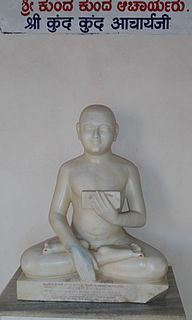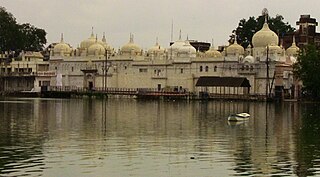
Chanderi, is a town of historical importance in Ashoknagar District of the state Madhya Pradesh in India. It is situated at a distance of 127 km from Shivpuri, 37 km from Lalitpur, 55 km from Ashok Nagar and about 46 km from Isagarh. It is surrounded by hills southwest of the Betwa River. Chanderi is surrounded by hills, lakes and forests and is spotted with several monuments of the Bundela Rajputs and Malwa sultans. It is famous for ancient Jain Temples. Its population in 2011 was 33,081.

Dhundhar, also known as Jaipur region, is a historical region of Rajasthan state in western India. It includes the districts of Jaipur, Dausa, Sawai Madhopur, and Tonk and the northern part of Karauli District.

A Bhaṭṭāraka heads traditional Digambara Jain institutions. He is responsible for training scholars, maintenance of libraries, managing endowments, presiding over installation ceremonies and running Jain institutions.

Delhi is an ancient centre of Jainism, home to over 165 Jain temples. Delhi has a large population of Jains spread all over the city. It has had continued presence of a Jain community throughout its history, and it is still a major Jain centre.

Humcha / Hombuja is a small village near Ripponpet, Hosanagara taluk in Shimoga district in the Indian state of Karnataka. Humbaja Atishaya Jain Teerth Kshetra is famous for being home to an ancient temple of Goddess Padmavati, and to the Humbaj Matha (seminary/monastery), an important institution of the Jain community. This temple is considered to be very holy and is known for its cultural and historical heritage. Other notable highlights of the place are a lake that reputedly never dries up and a tree that likewise always remains green.

Bundelkhand, in the heart of India, has been an ancient centre of Jainism. It is mostly in modern Madhya Pradesh, but part of it is in Uttar Pradesh.

Bagherwal is a Jain community originated from Baghera, a princely state in Rajasthan. Presently this town is situated in Ajmer district of Rajasthan near Kekri.
Kirti Stambha is a 12th-century tower situated at Chittor Fort in Chittorgarh town of Rajasthan, India. The 22 metres (72 ft) tower was built by a Jain merchant Jeeja Bhagerwala during the reign of Rawal Kumar Singh in c. 1179–1191 CE.
Kashtha Sangha was a Digambar Jain monastic order once dominant in several regions of North and Western India. It is considered to be a branch of Mula Sangh itself. It is said to have originated from a town named Kashtha.

Parwar, also spelt as Paravāra, is a major Jain community from the Bundelkhand region, which is largely in Madhya Pradesh, but also includes [Lalitpur District, Jhansi District of Uttar Pradesh] region of Uttar Pradesh. Apart from this District Nagpur (Maharashtra) have also a very large Parwar community. There is an area in Itwari of Nagpur known as Parwar-Pura having large number of Parwar's homes and shops. Most of the Nagpur's Parwar are migrated from Sagar, Deori, and other small villages of Sagar District of MP. Parwar exclusively follow the Digambar Jain tradition. Parwar usually preferred their marriage within community. There are 12 Gotra in Parwar community. Each Gotra has 12 Moor (lineages). A marriage within the same gotra or lineage are not allowed. Traditionally a marriage within any of the 8 branches was not permitted and hence the community was termed ashta-shakha.
Bahuriband, near Katni in Madhya Pradesh, is a famous inscription at the feet of a colossal stone image of Jain Tirthankara Shantinath. The colossal statue is 12 ft 2 in (3.71 m) in height.
Jivaraja Paprival was the installer of as many as 100,000 Jain images in the 15th century, now found in Jain temples all over India. He was a trader in the town of Modasa believed to be in Gujarat. He was probably born in Surat, Gujarat.
Jainism is an ancient Indian religion belonging to the śramaṇa tradition. It prescribes ahimsa (non-violence) towards all living beings to the greatest possible extent. The three main teachings of Jainism are ahimsa, anekantavada (non-absolutism), aparigraha (non-possessiveness). Followers of Jainism take five main vows: ahimsa, satya, asteya, brahmacharya (chastity), and aparigraha. Monks follow them completely whereas śrāvakas (householders) observe them partially. Self-discipline and asceticism are thus major focuses of Jainism.

A Pattavali, Sthaviravali or Theravali, is a record of a spiritual lineage of heads of monastic orders. They are thus spiritual genealogies. It is generally presumed that two successive names are teacher and pupil. The term is applicable for all Indian religions, but is generally used for Jain monastic orders.

Digambara is one of the two major schools of Jainism, the other being Śvētāmbara (white-clad). The Sanskrit word Digambara means "sky-clad", referring to their traditional monastic practice of neither possessing nor wearing any clothes.
Vidyadhar Pasusa Johrapurkar is a Sanskritist, social anthropologist and historian. His name is sometimes spelt as Vidyadhar Pasusa Joharapurkar.

Jainism is an Indian religion which is traditionally believed to be propagated by twenty-four spiritual teachers known as tirthankara. Broadly, Jainism is divided into two major schools of thought, Digambara and Svetambara. These are further divided into different sub-sects and traditions. While there are differences in practices, the core philosophy and main principles of each sect is the same.

Bara Mandir is a historic Jain temple in Jabalpur, right on the edge of Hanumantal, once the main center of Jabalpur.

Nirvana Kanda is an ancient Prakrit Jain composition that describes the sacred sites where Jain sages have attained Nirvana. It is also termed Nirvana Bhakti.

The Humcha Jain temples or Humcha basadis are a group of temples found in Humcha village of Shimoga district in Karnataka, India. They were constructed in the 7th century CE in the period of the Santara dynasty and are regarded as one of the major Jain centres of Karnataka. The Padmavati Basadi is the most well-known of these temples.















